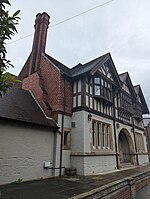Scarborough Bridge, York

Scarborough Bridge carries the railway line to Scarborough over the River Ouse in York, England. The first bridge was built in 1845, and has been renovated and rebuilt at least twice since its initial opening. A new bridge was installed in 2015 at a cost of £6 million. The first bridge had a pedestrian walkway which was located between the two running lines on the deck of the bridge, this was later moved to the east side of the bridge (in the 1875 rebuild), and finally, in the 2010s rebuild, the walkway became a separate wider bridge. The bridge is still in daily use carrying Trans-Pennine services between Scarborough and either York, or Manchester and Liverpool.
Excerpt from the Wikipedia article Scarborough Bridge, York (License: CC BY-SA 3.0, Authors, Images).Scarborough Bridge, York
Dame Judi Dench Walk, York Bishophill
Geographical coordinates (GPS) Address External links Nearby Places Show on map
Geographical coordinates (GPS)
| Latitude | Longitude |
|---|---|
| N 53.9612 ° | E -1.0928 ° |
Address
Scarborough Bridge
Dame Judi Dench Walk
YO30 7BQ York, Bishophill
England, United Kingdom
Open on Google Maps









